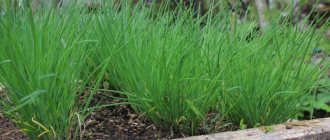Ornamental cabbage is no different in care from a regular table crop and can be eaten. Its main feature is bright, unusually colored leaves and rosettes resembling large flowers or ornamental trees. You can learn more about the varieties and methods of growing ornamental cabbage from this article.
Decorative cabbage
Ornamental cabbage is a biennial plant
Ornamental cabbage blooms until frost
Botanical description
Ornamental cabbage is classified as headless cabbage (Brassica oleracea var. Acephala), also called Brassica. Belongs to the cruciferous family. Biennial plant. In the first year, the leaves develop, forming a loose head or rosette; in the second year, the plant blooms and bears fruit.
The shape of ornamental cabbage leaves can be:
- solid and flat;
- pinnately dissected;
- corrugated;
- with fringed edge;
- with a curly edge.
The plant acquires the following colors:
- green on the lower leaves and white on the central ones;
- green on the lower ones and red-purple on the central ones;
- bright outer edge of the leaf and green in its central part;
- purple, pink, white central part and green edge of leaves;
- multi-colored leaves with contrasting veins.
The plant acquires a bright color when the temperature drops below +10 °C.
Cabbage can “bloom” in open ground until frosts of -12 °C, and after being moved to an unheated room - until mid-winter.
Historical data
Ancient Greece is considered the historical homeland of this type of cabbage. Here there was a special attitude towards the plant, since it was believed that the growth of the vegetable was provoked by drops of sweat from the god Jupiter.
Japanese breeders have made a lot of improvements in the variety of appearance of ornamental plants. Already in the middle of the 18th century, more than 200 varieties were bred here. Unusual-looking cabbage decorated the gardens of wealthy Japanese. Ornamental cabbage is widespread in European countries. In our country, it is just beginning to gain the attention of gardeners.
Where is it used and can it be eaten?
Ornamental cabbage is used in landscape design.
It can be planted:
- as part of compositions with flower plants - they form a contrasting spot against the background of other flowers and tall plants;
- as living borders - planted along paths and enclosing flower beds;
- in flowerpots and hanging flower pots – you can grow both individual plants and groups;
- as a single plant - completely plant the space with only ornamental cabbage;
- as part of compositions from different varieties - creating multi-colored patterns;
- in alpine slides - you can use both high and low varieties.
You can create original bouquets from Brassica. To do this, it is cut off at the root and placed in a vase with a small amount of water. To make the bouquet last longer, add a few crystals of potassium permanganate or 1 tsp to the water. sugar and a pinch of salt per 1 liter of water. Change the water 2 times a week, and the bouquet will last about a month.
In floristry, decorative cabbage is used to create vegetable bouquets.
Most often, ornamental cabbage was grown as a fodder plant, but it is quite edible, like cabbage or cauliflower. The leaves are rich in vitamins and can be a good source of them in winter.
A peculiarity of ornamental cabbage is that the leaves lose their bitter taste after the first frost.
Landing dates, place and conditions
Ornamental cabbage belongs to the mid-season and late-ripening groups of plants. The growing season lasts from 140 to 160 days. Rosettes of colored leaves form in August and persist until October, in some varieties until November.
The site for its planting must be selected taking into account the late “flowering” period. First, early and annual flowers should bloom, and cabbage should not cover them. It can be planted along the fence or left in pots and then transferred to a flower bed.
Brasseca loves open areas and semi-shaded areas. The soil it prefers is loam and sandy loam soil. Like any cabbage, ornamental varieties do not like acidic soil.
When growing in open ground, the site should be prepared in the fall:
- Application of fertilizing. 3 kg of compost, 50 g of superphosphate, 20 g of ammonium sulfate and 20 g of potassium chloride. Distribute the mixture over 1 square. m of land.
- Digging. Dig up the flowerbed.
- Watering. Moisturize well.
- Shelter. Cover the area with polyethylene or other insulating material so that the applied fertilizers rot well.
In the spring, remove the covering material and dig and loosen the soil well.
General characteristics of cauliflower
For lovers of healthy eating, the vegetable is indispensable, as well as for baby feeding.
An important quality is hypoallergenicity. An excellent supplier of plant fibers, therefore cauliflower is recommended to be included in the diet of people with gastrointestinal disorders.
Distributed everywhere, however, it is necessary to strictly approach the choice of varieties. Cabbages are divided into three groups according to the timing of head formation: early ripening, mid ripening and late. There are also ultra-early representatives.
| Important. When planning to grow white heads of cabbage on your site, remember: all three groups of varieties are successful only in regions with a warm climate. And early and middle varieties, with proper care, can yield a harvest at the end of the growing season even in the cooler conditions of central Russia, as well as in the central and southern regions of the Khabarovsk Territory. |
Sowing ornamental cabbage for seedlings
There are 2 ways to grow cabbage for seedlings. Whichever one you choose, you will have to take into account some nuances.
Tips for growing seedlings
Being a cold-tolerant plant, cabbage will react negatively to heat rather than cold. Keep this in mind if you want to grow seedlings in a hot apartment. In such conditions it is better to wait until April or May. During these periods, you can still grow seedlings, although March-April is considered the ideal time.
After the first shoots appear, on about the 5th day, the container with the seedlings should be moved to a cool place and provided with good lighting for 12-15 hours a day. Otherwise, the plants will become very tall. Phytolamps are used to illuminate seedlings. If it is not possible to provide lighting to the seedlings, it is better to wait until the day naturally increases.
Ornamental cabbage seedlings are often affected by fungal diseases, so the seed and soil should be disinfected before planting:
- the soil is calcined in the oven;
- after cooling, treat with Fitosporin;
- in a damp-wet state, the soil is left for several hours;
- the seeds are soaked for 3-4 hours in a solution of Fitosporin or kept for 20 minutes in water at a temperature of 50 ° C, and then in a solution of potassium permanganate.
After these steps, you can begin sowing. Granulated, purchased seeds can be planted immediately without additional processing.
With a pick
This method is used if you need to grow a large amount of seedling material.
Sequence of work:
- Fill the containers with soil. Its thickness should be at least 5 cm. Lightly compact it.
- Make grooves 0.5-1 cm deep. There should be a distance of 3 cm between the grooves.
- Place the seeds in grooves 1 cm apart. To do this, it is convenient to use a match or a toothpick.
- Fill the grooves with soil and compact it slightly so that there are no air pockets inside.
- Moisten the soil. Make sure it is damp but not puddling.
- Create a greenhouse. To do this, cover the container with polyethylene and secure it with an elastic band around the perimeter.
- Place the seedlings in a warm place. The temperature should be within +18-+24 °C. Light doesn't really matter at this stage.
If the work is carried out correctly, there is no need to water the cabbage before picking. After the first true leaves appear, after about 8-12 days, the cabbage is picked:
- Prepare the required number of pots with a volume of 250 ml and fill them with soil mixture treated with Fitosporin.
- Holes 2-3 cm deep are made in the ground.
- Each sprout is dug out with a small spatula, along with a lump of earth, and transferred to pots.
- Plants are deepened down to the cotyledon leaves. The earth around is being compacted.
- Plants are watered by spraying with warm water.
- Seedlings need to be fed before transplanting into the soil with liquid vermicompost or Agricola fertilizer. The procedure is carried out:
- on the 14th day after sowing;
- on day 28;
- before planting in the ground.
- 10 days before planting in a flower bed, the seedlings are hardened off. First, they open the window, and then take it out onto the street or balcony. Start with 30 minutes, gradually increasing this time to the whole day.
Without picking
It involves sowing seeds directly into separate pots:
- Prepare the required number of pots and fill them with prepared soil.
- Holes up to 1 cm deep are made in the soil (1 pot - 1 hole).
- Place 2-5 seeds in each hole and cover with soil.
- The pots are covered with polyethylene, creating greenhouse conditions.
- After germination, weak shoots are removed, cutting them off close to the ground with sharp thin scissors (you can use nail scissors), leaving one of the healthiest seedlings.
Planting ornamental cabbage in open ground
The optimal temperature for transplantation is considered to be +14-+18 °C. The soil should warm up to +8-+10 °C.
Cabbage can withstand night frosts down to -4 °C without harm.
At the time of transfer to the ground, the plant should develop 2-3 pairs of true leaves. The transplant is carried out together with a clod of earth, so the seedling will take root better.
Work order:
- Prepare the wells . Planting pattern 25x40 cm. Pour 1 tsp into each hole. complex fertilizer and ash.
- Transfer. Transfer each seedling to a separate hole. They deepen it to the cotyledon leaves and cover it with earth, slightly compacting it.
- Shelter. The seedlings are covered with agrofibre until the plant takes root.
Interesting varieties
The most commonly grown varieties are from the Pigeon, Kyoto, Osaka, Kamome, and Tokyo series. Interesting are the varieties from the Coral series - with very lacy leaves and a dense rosette.
Plants are divided into low varieties - 30-40 cm high and high - 50-60 cm. Tall varieties are suitable for bouquets, but short varieties are more popular.
Interesting hybrids and varieties of ornamental cabbage:
- “Lace Mosaic” is a variety with curly leaves of different colors (green, purple, white). Height – 50-60 cm. Withstands frosts down to -8-10 °C.
- 'White Cuff' is an F1 hybrid with green outer leaves and a creamy white curly center. Plant height – 30 cm.
- "Kai and Gerda" is a hybrid with corrugated leaves. Withstands negative temperatures down to -15 °C. Can grow in sun and partial shade.
- “Crane” Crane - the variety is actively used in floristry, twice as high as other varieties. The leaves of the plant are gradually removed from below until an unusual flower rosette forms at the top. Comes in different colors. Remains fresh for a long time after cutting.
- “Osaka Green White” Osaka Green White – the order of leaf color for this variety is reversed: the rosette of green upper leaves contrasts with the white background of the lower ones.
- "Chidori" Chidori - has dark green leaves with jagged edges surrounding a dense purple center. Grows up to 25 cm in height. Sowing seeds: from June to July.
- "Songbyod" Songbird - ideal for growing in a pot on a balcony or terrace. As temperatures drop in the fall, its leaves begin to turn green, pink and red, forming charming rosettes. They reach 25 cm. They are sown in May, when 3 pairs of leaves appear on the seedlings, they can be transplanted into pots.
- "Sunrise" Sunrise - resembles a multi-colored rose, the petals of which are colored green, red, yellow, white, pink. Several multi-colored rosettes grow on one stem, which appear 2 months after planting. You can plant them in flower beds or in boxes. Ideal for cutting. In spring, seeds are sown in boxes. Retains decorative value until late autumn.
- Kyoto Red Green Kyoto Red Green is one of the most popular purple-green varieties.
- “Peacock” Peacock - the variety pleases with openwork leaves, painted in different shades of green and white. Sow from June to July. Grows up to 30 cm.
- "Osaka Red" Osaka Red - has a conical shape. To make the rosette attractive, the lower leaves should be systematically removed. The leaves are purple-pink in color and have pink veins.
- “Prince Coral” Prince Coral is a variety with very dense leaves of an original white color. The variety is resistant to unfavorable conditions and tolerates waterlogging and low temperatures.
- "Round White" Round White - with cream and green leaves.
- "Victoria" Victoria - with green and pink-cream leaves.
- "Coral Queen" Coral Queen - with burgundy leaves.
Varieties from the CRANE series produce beautiful “flowers” that are ideal for cut flowers. They are colorful and grow up to 15 cm in diameter. Seeds are sown from May to August, when the seedlings already have 3 pairs of true leaves, they can be replanted for their intended purpose. The CRANE series includes many beautiful varieties: Red (red), White (cream), Bicolor (multi-colored), Rose (dark pink).
Planting cabbage from seeds
Ornamental cabbage seeds can be purchased at a specialty store or collected from the garden.
How to collect seeds?
Cabbage produces an arrow in which the seeds ripen in the 2nd year of life. Only the best rosettes are selected for seeds. To collect them:
- In the fall, dig up the cabbage by the roots from the garden bed;
- remove the lower leaves;
- bury leaves up to the leaves in a container with wet sand;
- store in this condition until spring in a well-ventilated, cool and dry place;
- in the spring, transplant the rosette into the ground;
To improve pollination, plant cabbage plants close to each other.
- in June the cabbage will begin to shoot arrows;
- the seeds in the pods will ripen by November;
- When they are well dry, cut them off and thresh them.
To prevent birds from eating the seeds, the arrows are tied with cloth.
Sowing in greenhouse conditions
Before sowing seedlings in a greenhouse, first prepare the soil:
- mix the soil from the site, peat and sand so that the layer thickness is 10 cm;
- disinfect this substrate.
Next, sow the seeds:
- moisten the soil well, but do not flood it;
- make small depressions in the ground;
- Place 2-3 seeds in each hole;
- sprinkle them with earth;
- you can cover the bed with polyethylene to increase the temperature;
- after germination, remove the cover;
- carry out loosening and watering.
When the plants have 2-3 true leaves, you can transfer the seedlings to open ground.
Sowing in open ground
"Brassica" can be sown immediately in open ground. It is better to do this in late April-early May. In unfavorable weather conditions, temporary shelter should be provided.
Work order:
- Preparation. Loosen the soil well.
- Watering. Moisten the soil with hot water with the addition of potassium permanganate, this will also serve as disinfection;
- Holes or grooves. Make small holes up to 1.5 cm deep at a distance of 15 cm from each other; you can make grooves of the same depth.
- Sowing. Place seeds in each groove at a distance of 5 cm from each other, or 1-3 seeds in each hole and cover with soil.
- Shelter. Cover each hole with a cut bottle. Install arcs along the rows and stretch the film over them.
In cold weather, seedlings can wait up to 2-3 weeks.
- Removing cover. When the sprouts hatch, the cover must be removed.
- Watering. Start after the true leaf appears. During watering, alternate the solution of Fitosporin and complex fertilizer.
- Thinning. Thin out the seedlings as they grow, leaving the strongest ones.
- Transfer. After 2-3 true leaves appear, the plants can be moved to a permanent location.
Autumn care and wintering
In autumn, the bushes are dug up along with the ground, the lower leaves are cut to the middle. Replant in a pot with sand up to the level of the upper leaves and transfer to a dry, well-ventilated room. In spring, the seedlings are planted in the ground again. The second year marks the period of ripening of seeds, which are collected and used for the next planting.
The peduncle is formed in the center of the leaf rosette. It blooms in September and seed pods appear. The bush should be dug up, put a bag on it and hung with the leaf rosette down in a cool, dry place. The seeds remain viable for about 5 years.
How to care for ornamental cabbage?
Even a novice gardener can handle caring for ornamental cabbage.
Watering
Ornamental cabbage varieties need to be watered in a timely manner. To do this, 10 liters of water moisten 1 square meter. m of soil. In stable hot weather, watering is carried out every day in the morning or evening.
Cabbage grown in containers is watered abundantly in the morning or evening, and also sprayed to reduce evaporation.
Loosening
After watering, the soil needs to be loosened, thus improving air exchange in the root zone and roots. Carry out the procedure once every 7 days.
In addition to loosening, carry out hilling. Rake the soil under each bush. This way you can prevent the grown cabbage rosette from falling over, which becomes too heavy to stay on the stem.
Weeding
Periodically weed flower beds with ornamental cabbage. It is best to combine it with watering and loosening - it is easier to remove weeds along with the roots from wet, loose soil.
The flowerbed can be mulched with any suitable material: sawdust, straw, shavings, mown grass, dried weeds. Thereby reducing the number of watering, weeding and loosening.
Fertilizer
You need to feed ornamental cabbage 3 times per season:
- 2 weeks after planting. Add a solution of urea (30 g per 1 sq. m) or mullein (diluted in water 1 to 10). Nitrogen fertilizers are used with caution, as they help increase green mass, but impair the decorativeness of plants.
- In 3-4 weeks. Nitroammofoska (10 g for each plant) or Azofoska solution (30 g diluted in 0.5 liters of water) is embedded in the soil.
- After another 3-4 weeks, repeat the 2nd feeding.
On poor soils, fertilizing is applied 4-5 times per season.
Outdoor care
Growing ornamental cabbage on the plot does not require any special hassle.
Feeding and fertilizer
Ornamental cabbage responds well to fertilizing. From the beginning of summer until the end of the growing season, mineral fertilizers are applied to it, alternating them with mullein infusion. If the soil was fertilized with organic matter before planting, the leaves will be larger, but their predominant color will be green. Brassica does not like excess nitrogen. It becomes less resistant to diseases and pests. A balanced composition of fertilizers, on the contrary, prevents the appearance of characteristic diseases, in particular blackleg.
During the season, fertilizing is carried out 2-5 times, depending on the type of crop.
Watering
Like all cabbages, brassica loves moisture. In order for a lush bush to grow, the soil underneath must be constantly moist, but not swampy. To avoid frequent watering, it is better to mulch the soil under the plant with dry grass, straw or sawdust. Mulch will avoid the need to regularly loosen the soil after watering.
Loosening
The plant prefers light, well-permeable soil. To saturate the roots with oxygen, it must be loosened periodically. On average, once a week after watering.
Diseases, pests and prevention
Brassica can be affected by diseases and pests, just like table cabbage.
The most common diseases can be caused by:
- Excessive watering. Never allow the soil to become waterlogged and do not use cold water. Otherwise, there is a danger of developing powdery mildew and root rot.
- Excessive nitrogen fertilization. Increases susceptibility to disease.
- Acidic soil. Becomes the cause of clubroot development. If necessary, deoxidize the soil with lime or dolomite flour.
If infection cannot be avoided:
- at the initial stage, you can use the fungicides Fundazol, Quadris, Tiovit Jet;
- in case of severe damage, the rosettes should be removed from the garden bed.
Of the pests, ornamental cabbage is most often affected by:
- butterflies and caterpillars of cutworms and white moths;
- cruciferous flea beetle;
- aphids;
- slugs.
You can use the following tools and methods:
- insecticides Aktara, Bicol, Decis Profi;
- spraying the planting every 10-14 days with an infusion of tobacco dust (infuse 2 cups per 5 liters of water for 24 hours) with the addition of a few tablespoons of liquid soap;
- pollinate plants with ash with the addition of tobacco dust;
- plant a flowerbed with marigolds or other strong-smelling plants;
- mulch with pine needles;
- collect slugs and caterpillars by hand or lay out special traps.
Reproduction
Ornamental cabbage propagates only by seeds, but the plant should not be classified as a hybrid. Hybrid seeds collected at home do not retain their color and decorative characteristics. Harvested seeds can be stored for 5 years.
High-quality seed of hybrids can be purchased from the following companies:
- Gavrish;
- Russian vegetable garden;
- Aelita;
- Search;
- SeDek.
What ornamental cabbage is, as well as how to care for it, can be found out while watching the video:
Benefits and harms
Beneficial features:
- The vegetable is rich in vitamins, stimulates the immune system and speeds up recovery.
- Regular consumption strengthens blood vessels and improves the functioning of the circulatory and cardiovascular systems, preventing stroke.
- An excellent choice for the first feeding of babies.
- It has a positive effect on the functioning of the intestines and the state of its microflora.
- Reduces the risk of cancer.
- Kills germs and prevents the appearance of ulcers and tumors.
- Regulates cholesterol levels.
- Has an anti-inflammatory effect.
- Improves skin condition and rejuvenates the body.
- Has a stabilizing effect on the nervous system.
Important! Excessive consumption of this product can lead to exacerbation of gastrointestinal diseases and cause heartburn.
The benefits and harms of cauliflower, as well as the composition and calorie content of the vegetable are written here.
Watch a video about the benefits and harms of cauliflower:
Reviews
★★★★★
Svetlana, 35 years old. Every year I sow ornamental cabbage.
First, I sow in a greenhouse at the end of April or beginning of May, depending on the weather, and grow seedlings. After transferring it to the flowerbed, I always treat it with Intavir. To be honest, I don’t really like the plant, of course, in the fall - it’s gorgeous, but all summer it doesn’t present any beauty and you can’t cover it with other plants so that it doesn’t stretch out. ★★★★★
Tamara, 43 years old. I plant Brassica from time to time.
For those who want to experiment, I can say that the caterpillars eat it with the same appetite as regular food, so you need to keep an eye on it so that the beauty does not end up in holes. But with the onset of cold weather, it can be forgiven for all the additional treatments - the flowers have already faded, the caterpillars have hidden, and the cabbage “blooms” in all shades. This is simply the queen of autumn. ★★★★★
Maria, 28 years old. Last year I sowed ornamental cabbage directly into a flower bed with annual flowers.
And it was my mistake - over time it “strangled” all the flowers, and by the end of summer it was eaten by slugs. I had to remove it without waiting for the beauty. This year I bought seedlings right away - beautiful plants, already bright. I planted it at the end of May, and since June, it has become all overgrown with arrows and strange flowers. Disappointed. Hide
Add your review
Growing and caring for ornamental cabbage is no different from ordinary cabbage. You will have to grow seedlings, monitor soil moisture, weed, and fight pests and diseases. But, with a little patience and choosing a suitable place, from the beginning of autumn until frost, you can enjoy the variety of colors of luxurious rosettes.
0
0
Copy link











